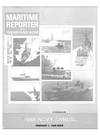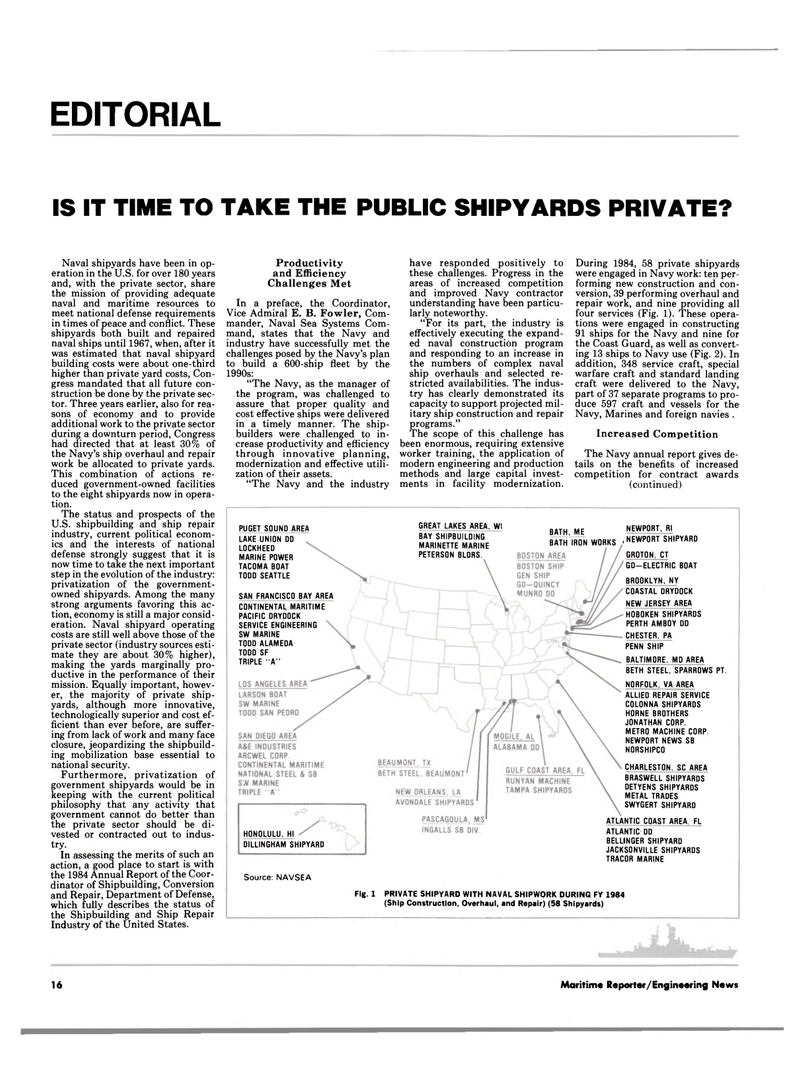
Page 14: of Maritime Reporter Magazine (February 1986)
Read this page in Pdf, Flash or Html5 edition of February 1986 Maritime Reporter Magazine
EDITORIAL
IS IT TIME TO TAKE THE PUBLIC SHIPYARDS PRIVATE?
Naval shipyards have been in op- eration in the U.S. for over 180 years and, with the private sector, share the mission of providing adequate naval and maritime resources to meet national defense requirements in times of peace and conflict. These shipyards both built and repaired naval ships until 1967, when, after it was estimated that naval shipyard building costs were about one-third higher than private yard costs, Con- gress mandated that all future con- struction be done by the private sec- tor. Three years earlier, also for rea- sons of economy and to provide additional work to the private sector during a downturn period, Congress had directed that at least 30% of the Navy's ship overhaul and repair work be allocated to private yards.
This combination of actions re- duced government-owned facilities to the eight shipyards now in opera- tion.
The status and prospects of the
U.S. shipbuilding and ship repair industry, current political econom- ics and the interests of national defense strongly suggest that it is now time to take the next important step in the evolution of the industry: privatization of the government- owned shipyards. Among the many strong arguments favoring this ac- tion, economy is still a major consid- eration. Naval shipyard operating costs are still well above those of the private sector (industry sources esti- mate they are about 30% higher), making the yards marginally pro- ductive in the performance of their mission. Equally important, howev- er, the majority of private ship- yards, although more innovative, technologically superior and cost ef- ficient than ever before, are suffer- ing from lack of work and many face closure, jeopardizing the shipbuild- ing mobilization base essential to national security.
Furthermore, privatization of government shipyards would be in keeping with the current political philosophy that any activity that government cannot do better than the private sector should be di- vested or contracted out to indus- try.
In assessing the merits of such an action, a good place to start is with the 1984 Annual Report of the Coor- dinator of Shipbuilding, Conversion and Repair, Department of Defense, which fully describes the status of the Shipbuilding and Ship Repair
Industry of the United States.
Productivity and Efficiency
Challenges Met
In a preface, the Coordinator,
Vice Admiral E. B. Fowler, Com- mander, Naval Sea Systems Com- mand, states that the Navy and industry have successfully met the challenges posed by the Navy's plan to build a 600-ship fleet by the 1990s: "The Navy, as the manager of the program, was challenged to assure that proper quality and cost effective ships were delivered in a timely manner. The ship- builders were challenged to in- crease productivity and efficiency through innovative planning, modernization and effective utili- zation of their assets. "The Navy and the industry have responded positively to these challenges. Progress in the areas of increased competition and improved Navy contractor understanding have been particu- larly noteworthy. "For its part, the industry is effectively executing the expand- ed naval construction program and responding to an increase in the numbers of complex naval ship overhauls and selected re- stricted availabilities. The indus- try has clearly demonstrated its capacity to support projected mil- itary ship construction and repair programs."
The scope of this challenge has been enormous, requiring extensive worker training, the application of modern engineering and production methods and large capital invest- ments in facility modernization.
During 1984, 58 private shipyards were engaged in Navy work: ten per- forming new construction and con- version, 39 performing overhaul and repair work, and nine providing all four services (Fig. 1). These opera- tions were engaged in constructing 91 ships for the Navy and nine for the Coast Guard, as well as convert- ing 13 ships to Navy use (Fig. 2). In addition, 348 service craft, special warfare craft and standard landing craft were delivered to the Navy, part of 37 separate programs to pro- duce 597 craft and vessels for the
Navy, Marines and foreign navies .
Increased Competition
The Navy annual report gives de- tails on the benefits of increased competition for contract awards (continued)
PUGET SOUND AREA
LAKE UNION DD
LOCKHEED
MARINE POWER
TACOMA BOAT
TODD SEATTLE
SAN FRANCISCO BAY AREA
CONTINENTAL MARITIME
PACIFIC DRYDOCK
SERVICE ENGINEERING
SW MARINE
TODD ALAMEDA
T000 SF
TRIPLE "A"
GREAT LAKES AREA, Wl
BAY SHIPBUILDING
MARINETTE MARINE
PETERSON BLDRS.
BATH, ME
BATH IRON WORKS
NEWPORT, Rl , NEWPORT SHIPYARD
GROTON, CT
GD-ELECTRIC BOAT
BROOKLYN, NY
COASTAL DRYDOCK
NEW JERSEY AREA
HOBOKEN SHIPYARDS
PERTH AMBOY DD
CHESTER, PA
PENN SHIP
BALTIMORE, MP AREA
BETH STEEL, SPARROWS PT.
NORFOLK, VA AREA
ALLIED REPAIR SERVICE
COLONNA SHIPYARDS
HORNE BROTHERS
JONATHAN CORP.
METRO MACHINE CORP.
NEWPORT NEWS SB
NORSHIPCO
CHARLESTON, SC AREA
BRASWELL SHIPYARDS
DETYENS SHIPYARDS
METAL TRADES
SWYGERT SHIPYARD
FL
HONOLULU, HI
DILLINGHAM SHIPYARD
ATLANTIC COAST AREA
ATLANTIC DD
BELLINGER SHIPYARD
JACKSONVILLE SHIPYARDS
TRACOR MARINE
Source: NAVSEA
Fig. 1 PRIVATE SHIPYARD WITH NAVAL SHIPWORK DURING FY 1984 (Ship Construction, Overhaul, and Repair) (58 Shipyards) 16 Maritime Reporter/Engineering News

 13
13

 15
15
